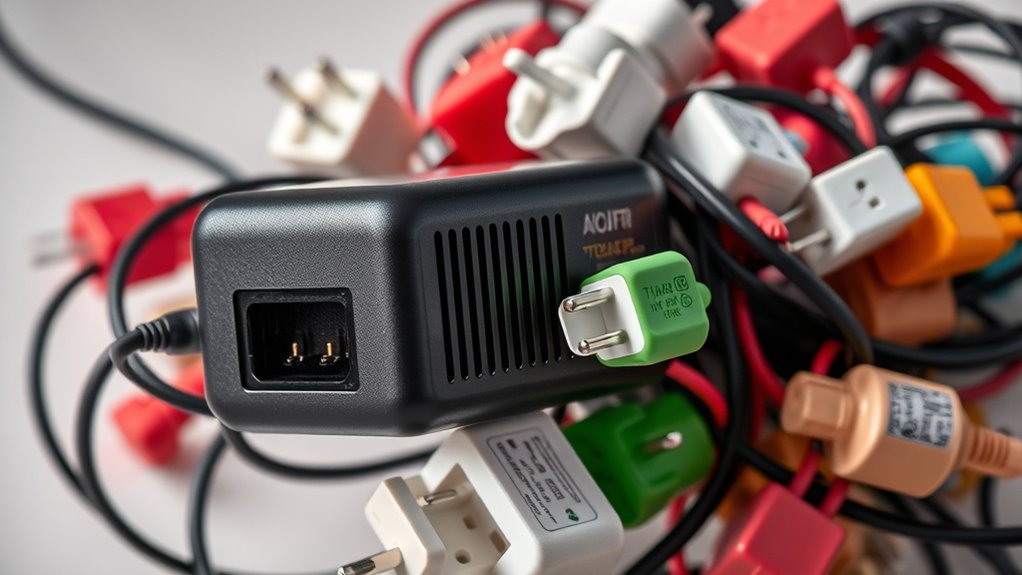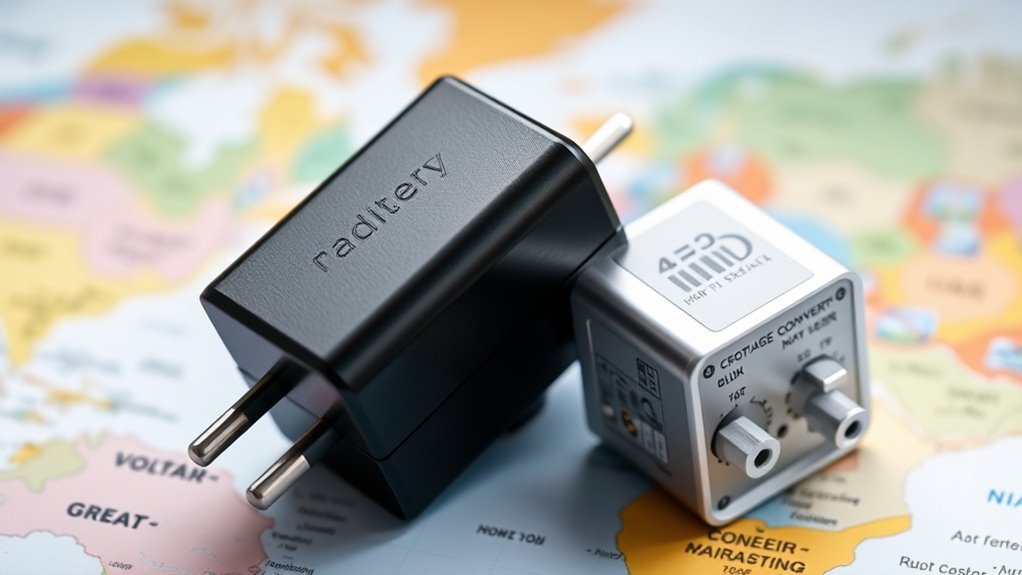To use power adapters and voltage converters safely, first check your device’s voltage requirements. If your device is dual voltage, only an adapter is needed to fit different plug types. For single voltage devices, you’ll need a voltage converter to match the local power supply. Always verify the converter’s wattage capacity exceeds your device’s power needs and choose certified products for safety. Keep exploring to learn more about pairing these tools correctly for safe and reliable operation.
Key Takeaways
- Understand the difference between power adapters (which change plug types) and voltage converters (which adjust voltage levels).
- Check device voltage specifications and ensure the converter matches the device’s wattage requirements.
- Use certified adapters and converters with proper safety features to prevent electrical hazards.
- Know the plug types and voltage standards of your destination country to select compatible power solutions.
- For non-dual voltage devices, always use a voltage converter to prevent damage or safety risks.

When traveling or using electronic devices in different countries, understanding power adapters and voltage converters is vital. These tools guarantee your devices work safely and efficiently, preventing damage or safety hazards. One of the first things to contemplate is battery compatibility. Many devices, especially those with rechargeable batteries like cameras, laptops, or smartphones, are designed to operate within specific voltage ranges. If you plug a device with a battery that isn’t compatible with the local voltage, it could lead to overheating, reduced battery life, or even permanent damage. To avoid this, always check your device’s voltage specifications—usually printed on the power brick or in the user manual—and compare them with the voltage standards of the country you’re visiting. Some devices are dual voltage, meaning they can handle 110V and 220V, but if yours isn’t, you’ll need a voltage converter to match the local power supply. Understanding the importance of voltage compatibility helps prevent device damage and ensures safe operation.
Safety standards are equally vital when selecting power adapters and voltage converters. Different countries have varying safety regulations, so using equipment that doesn’t meet the local safety standards can pose risks like electrical shocks, fires, or appliance failures. Look for adapters and converters that are certified by recognized safety organizations, such as UL, CE, or FCC. These certifications ensure the products adhere to strict safety and quality standards, giving you peace of mind during your travels or daily use. When using a voltage converter, make sure it’s rated for the wattage your device requires; overloading a converter can cause overheating or failure. Also, many modern adapters incorporate safety features like surge protection, built-in fuses, or overheating shutdowns, which help prevent accidents.
In addition to safety standards, consider the physical compatibility of your devices with the adapter. Different countries use different plug types, so you might need a universal or multi-port adapter that accommodates various plug shapes. This prevents you from forcing incompatible plugs into outlets, which can damage the device or the outlet itself. Remember, an adapter alone doesn’t change the voltage; if your device isn’t dual voltage, a voltage converter is necessary. Combining the right adapter with a proper converter ensures your device receives the appropriate power level, remains safe, and functions properly regardless of where you are. Being aware of power voltage standards is essential for safe and effective device operation worldwide.
Frequently Asked Questions
Can I Use a Power Adapter With Multiple Devices Simultaneously?
You can’t safely use a power adapter with multiple devices simultaneously unless it’s specifically designed for that purpose. Always check device compatibility to guarantee the adapter can handle the combined power requirements. Follow safety precautions, like avoiding overloads and using surge protectors, to prevent damage or electrical hazards. If in doubt, consult the manufacturer’s guidelines or a professional to avoid risking your devices or safety.
What Should I Do if My Voltage Converter Overheats?
If your voltage converter overheats, stop using it immediately to prevent damage or fire. Investigate whether overheating is caused by overload or poor ventilation. To prevent future issues, guarantee proper overheating prevention by keeping thermal safety features in check and placing the converter in a well-ventilated area. Regularly inspect for dust or debris that could block airflow. Always prioritize safety to protect your devices and home.
Are There Universal Adapters Compatible Worldwide?
Yes, you can find universal adapters compatible worldwide. They typically support multiple plug types, making them versatile for different countries. Just verify you check their compatibility with your device’s voltage and wattage, and look for safety certification to guarantee safe usage. These adapters usually come with interchangeable plug heads, so you can easily switch between different countries’ plug types and stay protected with certified safety features.
How Long Do Power Adapters Typically Last?
Power adapters typically last between 2 to 5 years, depending on usage and build quality. You can estimate their lifespan by considering adapter durability, such as how well it withstands heat and wear. Proper care, like avoiding overloads and keeping it cool, can prolong its lifespan. Regularly inspecting for damage and replacing it when necessary ensures safe and reliable performance over time.
Do Voltage Converters Affect Device Performance or Lifespan?
Sure, voltage converters might seem like magic wands, but they actually influence your device’s performance and lifespan. When you mess with device compatibility and introduce power fluctuations, you risk short-term glitches or long-term damage. Think of it as giving your device a wild roller coaster ride—fun, but not always safe. Keep a close eye on compatibility and stabilize power to protect your gadget’s health and longevity.
Conclusion
So, now you’re basically a tech wizard, armed with the knowledge to conquer any outlet worldwide. No more fretting over incompatible plugs or voltage mishaps—just plug, play, and pretend you’re a global gadget guru. Just remember, with great power (adapters) comes great responsibility (not frying your devices). So go forth, travel confidently, and impress everyone with your newfound voltage prowess—because nothing screams “world traveler” like a perfectly powered device.









